Appropriately this Women's History Month 2012, a piece of Women's Correction History has been found that may be a clue in solving the mystery of an undated New York City Department of Correction (NYC DOC) uniform specifications booklet.

Peter F. Amoroso, M.D.
Commissioner
10/16/40 -- 12/27/46The three-page section summarizing NYC DOC history in the 1946 annual report is attributed by this web site to Doctor Peter F. Amoroso's administration because it was prepared by his staff even though the name appearing on the complete report's cover and title page is that of Albert Williams, his successor.
Amoroso, in his 1941 annual report, had particularly mentioned that preparations were underway to chronicle NYC DOC history.
That history is summarized in the opening pages of the 1946 annual report submitted to Mayor William O'Dwyer by Albert Williams only five days after his having been named Commissioner.
Amoroso had resigned Dec. 27, 1946. The annual report, including the history, was sent to the mayor by Williams on Jan. 1, 1947. Clearly the work producing the report, including the historical summary, was carried out under Amoroso as Commissioner.
Click Amoroso image above to access the 1946 annual report's DOC history summary. Use your browser's "back" button to return.
|
Earlier in the month this site's webmaster began researching mid-1940s Correction Officers uniforms at the request of a movie production company preparing to shoot a film scripted to include a scene set in the Tombs of that era. He came across a 1944 news item related to women Correction Officers' uniforms: -- an order issed by Dr. Peter F. Amoroso, who served as Correction Commissioner from Oct. 16, 1940 to Dec. 27, 1946. That article reported the commissioner directed they replace their white nurse-like uniforms with blue serge garb similar to what police matrons wore.
But because female COs in the 1940s did not work in male inmate institutions, their custodial assignments being confined to women inmate facilities, the 66-year-old news clip did not appear relevant to the Tombs scene planned for the movie.
Unfortunately, the 1940s are a virtual black hole in the NYC DOC historical firmament in terms of achieved images, and nearly as meager in terms of documents. There abound images and official texts from the '30s and from the '50s but no '40s images and almost no '40s texts. Regretably, the available '30s and '50s photos are black-and-whites, not color.
Nevertheless, these photos of officers in the '30s and those in the '50s show uniforms that look remarkably similar, even arguably identical. One may reason that the Department would not have changed the '40s uniform appearance from the '30s and then changed back again in the '50s. Still, one would prefer direct evidence confirming that deduction.
1940s/'50s DOC Uniform Specifications Booklet
So our research continued and resulted last week in tracking down what this web site calls the "Mystery Booklet of NYC DOC Uniform Speifications." The soft-cover, letter-size 14-page publication's all-caps text opens with this sentence:
| THE FOLLOWING SPECIFICATIONS FOR UNIFORMS ARE HEREBY ADOPTED AND PRESCRIBED BY THE COMMISSIONER OF THE DEPARTMENT OF CORRECTION FOR THE USE OF THE MEMBERS OF THE DEPARTMENT.
|
That "hereby" declaration would make more sense if dated but nowhere in the booklet does any kind of date appear: not on its cover, nor its title page, nor any of its 14 numbered pages.
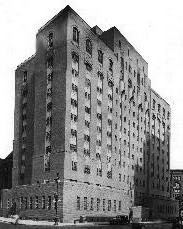
At the time of the 1944 Amoroso order and the uniform "specs" booklet, DOC's main custodial facility for housing female inmates was Women's House of Detention, at 6th Ave. & 10th St., Greenwich Village, Manhattan. It opened in 1932 and was demolished in 1974. |
|
The cover and the title page do carry the name of Albert Williams who served as NYC Correction Commissioner from Dec. 27, 1946 to December 31, 1953. However, the specifications may not have been ordered by Williams, but by his predecessor Amoroso.
With discovery of the undated nature of the uniformed specifications booklet, the women's CO uniform news clip from more than six decades ago has taken on a revelance not theretofore appreciated. The '44 news item helps establish that the specifications in the mystery booklet were not issued prior to 1944. With respect to the women COs' uniforms, the booklet specifications match with Doctor Amoroso's reported September, 1944 directive.
The 1944 story also helps demonstate Amoroso's interest in setting DOC uniform specifications. No news report of Williams showing a similar interest has emerged.
The headline and first two paragraphs of the New York Times Sept. 19, 1944 story read:
NEW UNIFORMS APPEAR
----
52 DEPARTMENT OF CORRECTION MATRONS DON BLUE SERGE
Fifty-two matrons employed by the Department of Correction were on duty yesterday in new uniforms of blue serge, similar to those worn by policewomen.
Heretofore the matrons, mostly assigned to the courts, wore white dresses, frequently with vari-colored sweaters. Peter F. Amoroso, Commissioner of Correction, recently issued an order instructing the matrons to wear blue uniforms.
|
The NYT reported that the Commissioner said the women welcomed the change but then quoted one of the women officers as calling the $40 cost to each of the 52 an "unnecessary" expense.
| "We were told to buy a skirt, a shirt and a jacket that I don't think will be worn except on Columbus Day, when we will have to parade in our new uniforms." |
| DO THESE DOC HATS
SHARE KINSHIP WITH UNDATED UNIFORM 'SPECS' BOOKLET SECTION 13 HAT? |
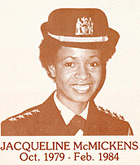
Chief of Operations |
| The above image of Jackie McMickens is derived from a Guardians dinner journal page featuring her photo and the photo of three other former Chiefs of Operations.
|
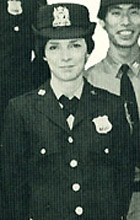
1978 Recruiter |
| Above unnamed CO and her hat appeared on a 1978 DOC Recruitment Card.
|

Unnamed DOC officer |
| The image immediately above is from Monroe College Prof. Errol D. Toulon's treasure trove of DOC-related photos.
|
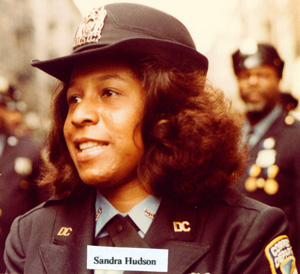
Sandra Hudson |
| The image immediately above and the one immediately below are both from Monroe College Prof. Errol D. Toulon's treasure trove of DOC-related photos. |
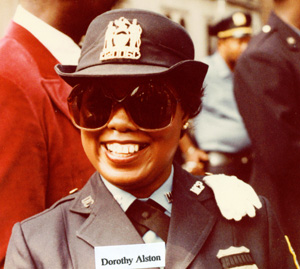
Dorothy Alston |
| Click any of the above images of five DOC women officers and their hats to access the respective pages on this web site from which they were taken. Use your browser's "back' button to return. |
| X |
While providing more precise details, the undated booklet's uniform "specs" for women officers in "all ranks" -- Section 13 of the publication's 22 numbered sections -- mirror what the Sept. 19, 1944 NYT article described in more general terms. Here is the booklet's Section 13 text that begins on Page 9 and concludes on Page 10.:
Full Text of Booklet Section 13:
Women COs' Uniform 'Specs' 13. UNIFORM FOR ALL RANKS (WOMEN):
COAT -- STYLE SAME AS WAVE PATTERN, FOUR BUTTON SINGLE
BREASTED SACK.
MATERIAL -- METCALF #386-14, FOURTEEN OUNCE BLUE SERGE,
MIDNIGHT BLUE,
BUTTONS -- FOUR 36-LIGNE "CITY OF NEW YORK" BUTTONS ON SHOULDER STRAPS; TWO 24-L1GNE BUITONS ON POCKET FLAPS. . . .
PLACING OF BUTTONS -- TOP BUTTON OF COAT TO BE ONE INCH
BELOW BUTTON OF BREAST POCKET. THIRD BUTTON OF COAT TO BE
ONE INCH ABOVE LOWER POCKET FLAP.
POCKETS -- TWO BREAST POCKETS WITH THREE POINT FLAPS
SLANTED UPWARD, INNER EDGE ONE INCH HIGHER THAN OUTER EDGE.
TWO LOWER POCKETS WITH THREE POINT FLAPS SLANTED UPWARDS,
INNER EDGE ONE INCH HIGHER THAN OUTER EDGE.
SHOULDER STRAPS -- PIPED MAROON SILK CORD. NO CROSS
STITCHING.
STITCHING -- FLAPS AND EDGES 1/8 8.8. PEAK LAPELS,
LININGS -- BEST QUALITY BLACK CELANESE COAT AND SLEEVE
LINING.
TRIMMINGS -- BEST QUALITY THROUGHOUT.
PROVISIONS FOR ATTACHING SHIELDS -- EYELETS ON BOTH
SIDES OF COLLAR FOR INSIGNIA.
SHIELD -- LEFT SIDE OF JACKET. CENTER OF SHIELD AT
INNER POINT OF POCKET FLAP. HEAVY SILK LOOPS TO HOLD SHIELD.
SKIRT: SEVEN PIECE SKIRT WITH ONE KICK PLEAT FOURTEEN AND
ONE-HALF INCHES LONG IN FRONT. TWO SIDE FRONT GORES RAISED.
TWO BACK GORES RAISED.
WAISTBAND, ONE AND ONE-HALF INCHES WIDE TO BUTTON
WITH EXTENSION, TWO HOOKS AND EYES INSIDE.
PLACKET, SIDE, TO FASTEN WITH HOOKS AND EYES.
(ZIPPER CLOSING, IF POSSIBLE), HANGERS ON EACH SIDE OF HIPS.
BLOUSE: WHITE BROADCLOTH, MAN-TAILORED, SUITABLE TO WEAR
WITH FOUR-IN-HAND TIE. (SIMILAR TO BLOUSE WORN BY RED
CROSS NURSES).
TIE: REGULATION BLACK FOUR-IN-HAND.
SHOES: BLACK LEATHER OXFORD MEDIUM HEEL.
GLOVES: WHITE COTTON.
STOCKINGS: DARK BEIGE SHADE.
HAT: MIDNIGHT BLUE FELT, BRIM TWO AND ONE-HALF INCHES
WIDE IN FRONT; TURNED DOWN; REDUCED TO ONE INCH IN BACK,
TURNED UP. MIDNIGHT BLUE GROSGRAIN RIBBON, ONE AND ONE
HALF INCHES WIDE, AROUND CROWN. MIDNIGHT BLUE FELT CORD
AROUND RIBBON CONNECTING TO "NEW YORK CITY" INSIGNIA (HAT
PIECE) CENTER FRONT OF CROWN. (BOTTOM EDGE OF INSIGNIA
EVEN WITH JOINING OF BRIM AND CROWN).
|
Mystery Format Change in Mystery Booklet
Not clear is why the format style of Women's Uniform Specifications Section text on Page 10 changed from what had been the section's text format style on Page 9 (and, for that matter, from what had been the format style of all the texts of all the various uniform specification sections on all the other previous pages of the booklet).
The previous text style underlined sub-topics and followed each with a space, a dash, and then another space. But beginning with the first sub-topic of Section 13's continuation on Page 10, SKIRT:, underlines were not used, and a colon replaced the spaces-sandwiched dash.
|
Interestingly, the previous text style of underlined sub-topics followed by a dash between spaces was resumed in the very next section on Page 10 (and, for that matter, in all the texts of all the various uniform specification sections on all the other subsequent pages of the booklet).
Clearly someone who had not typed the original text of the booklet, and who therefore was not aware of -- or sensitive to -- the format carefully followed by the original typist, inserted new text using a format style not appearing anywhere else in the booklet.
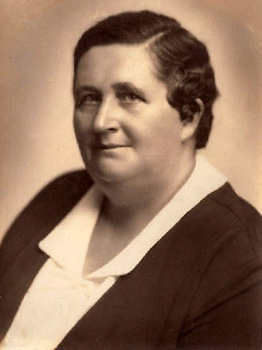
Matron Margaret Grosjean
To NYCHS:
. . . . my grandmother, Margaret Grosjean, was a NYC [correction] matron for a number of years during this period. She worked at the women's [house of detention] when it opened and used to tell the story that she was on the job the night Mae West was arrested and brought there.
Grandmother Margaret Grosjean retired as a prison matron in the late 1940s or early 1950s, I believe.
I am attaching a photo taken of her when she was a matron. She had this photo taken to give to her children, all 11 of them, as a keepsake. She had to raise them by herself after my grandfather, Henry Grosjean, was killed in a Sanitation accident in 1919.
Grandfather Grosjean worked for the City as a Sanitation Department employee. When he died, the pension to my grandmother was either $11 or $17 a month (the number is hard to make out on the document). Either way, it wasn't enough, which is why she went to work outside the home. 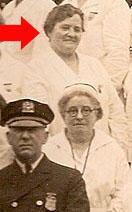 She took the matron job even though she had to give the pension up to do so. I see on your website that the DOC matron payroll for 1930 listed her annual pay as $1,920 . . . . She took the matron job even though she had to give the pension up to do so. I see on your website that the DOC matron payroll for 1930 listed her annual pay as $1,920 . . . .
I can't be sure if my grandmother is in the group photo you have. But she could be the woman in the center section in the middle row directly behind the lady with cap and glasses who, in turn, is behind the uniformed officer.
Once again, thank you for putting out this picture; it means a lot to people like me doing genealogy.
Caroline Hertz Click either above image to access the group photo page cited in Caroline Hertz' letter. Use your browser's 'back' button to return. |
|
Nowhere else in it are colons used with sub-topics; only in the Women's Uniform Specifications Section continuation on Page 10. But what changes were made in the substance of Section 13 text or why is not known.
Was Amoroso
Uniform 'Specs' Booklet's Prime Mover?
Nevertheless, the NYT "Correction Matrons Don Blue Serge" story of September 1944 does serve to indicate Women's Uniform Specifications set forth in Section 13 of the NYC DOC booklet had their origins in Dr. Amoroso's administration, not Williams' administration, and raises the stong possibility that issuance of a booklet covering the other uniform "specs" also originated in the doctor's administration.
If so, the booklet's publication would not have been the first time the Williams administration put forth without attribution something begun under Amoroso.
Though Commissioner only five days when the DOC 1946 annual report was officially issued Jan.1, 1947, Williams -- whose name appears on that annual report's cover and on the report's transmittal letter -- did not acknowledge in the report the role played by his predecessor in connection with its most singular feature -- the DOC's first known summary of its history, something we know from an earlier report was an Amoroso administration-initiated project.
Another factor for suspecting the Williams administration may not have initiated the specifications set forth in the booklet that bears his name on its cover and title page is its lack of an introduction, however brief, to which he would surely have appended his name as Commissioner and the date, had he in fact been the prime mover behind the "hereby adopted" specifications. One can argue that no way would he have failed to stamp his brand on them, had they been his.
The fact that no date appears anywhere in the document may be an indication that it represents more of a codification of existing regulations, not initiation of new regulations to take effect on a given date. Both the specifications and the codification may have begun under Amoroso, and the booklet -- like the 1946 annual report and its three-page DOC history summary of DOC -- came to fruition under Williams.
NYT 'Matrons Don Blue' Story Shortcomings
Useful as it is in helping to narrow the time frame for the undated uniform "specs" booklet's publication, the 1944 NYT "Matrons Don Blue" article is not without its own shortcomings.
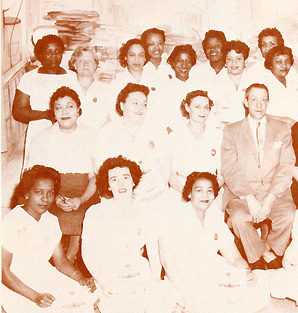
Above is the left half of large group photo of Women's House of Detention staff in 1959. It shows the women COs wearing their nurse whites. Click image to see the complete image of the photo. Use your browser's "back" button to return. |
|
Although not saying so explicitly, the story conveys the impression that the vast marjority of DOC's female officers were assigned to the courts and that regardless where assigned, all women COs replaced their nurse-like white uniforms with blue serge uniforms similar to what policewomen wore.
But, in fact, the number of women COs assigned to DOC's holding cells for female defendants at the courts came nowhere near constituting a majority of the DOC's women COs. Only if one counted those assigned to women cell areas in detention jails adjacent to the courts would the number have possibly approached being a majority of DOC's women COs. Nearly as many, if not always precisely an equal number, were assigned to DOC facilities housing only sentenced female inmates or housing both detention and sentenced female inmates. The Women's House of Detention in Greenwich Village was an example of the latter category. The DOC's female reformatory at Greycourt in Orange County, N.Y., was an example of the former category.
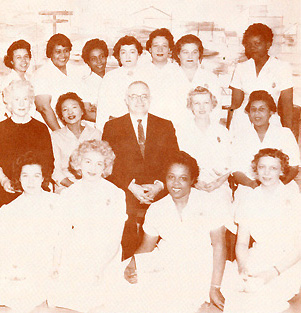
Above is the left half of large group photo of Women's House of Detention staff in 1959. It shows the women COs wearing their nurse whites. Click image to see the photo source: the NYC Correction Guardians' 50th anniversary souvenir journal. Use your browser's "back" button to return. |
|
Photos taken at the Women's H. of D. in the late 1950s and early 1960s show the nurse-like white uniforms still in use by women COs.
So, the practice after the September 1944 order by Dr. Amoroso appears to have been that blue serge was worn by women COs in those settings where male COs, policemen, and policewomen predominated -- all in blue serge. But where officers in blue serge were not predominate, women COs continued wearing their nurse whites.
In the absence of any documentation explaining the rationale behind this pattern, one may only speculate that their wearing blue serge helped convey women COs' equal status with the other authority figures in the blue serge settings. But in the settings where women COs were predominate, such as the Women's H. of D., they were the authority figures and therefore had no need to convey that fact by wearing blue serge. There their nurse whites were viewed as conveying more of the care aspect of Correction, considered a more effective approach in managing the female inmate population without compromising the custody and control aspects.
Anyone with a better explanation to suggest and/or actual information that might shed more light on any aspect connected with this "mystery uniform 'specs' booklet" is invited to email us at the e-address below.
|

![[NYC DOC uniform 'specs' booklet color cover]](uniforms-cvr-300x72.jpg)
![[NYC DOC uniform 'specs' booklet grayscale cover]](uniforms-cvr-grayx72.jpg)